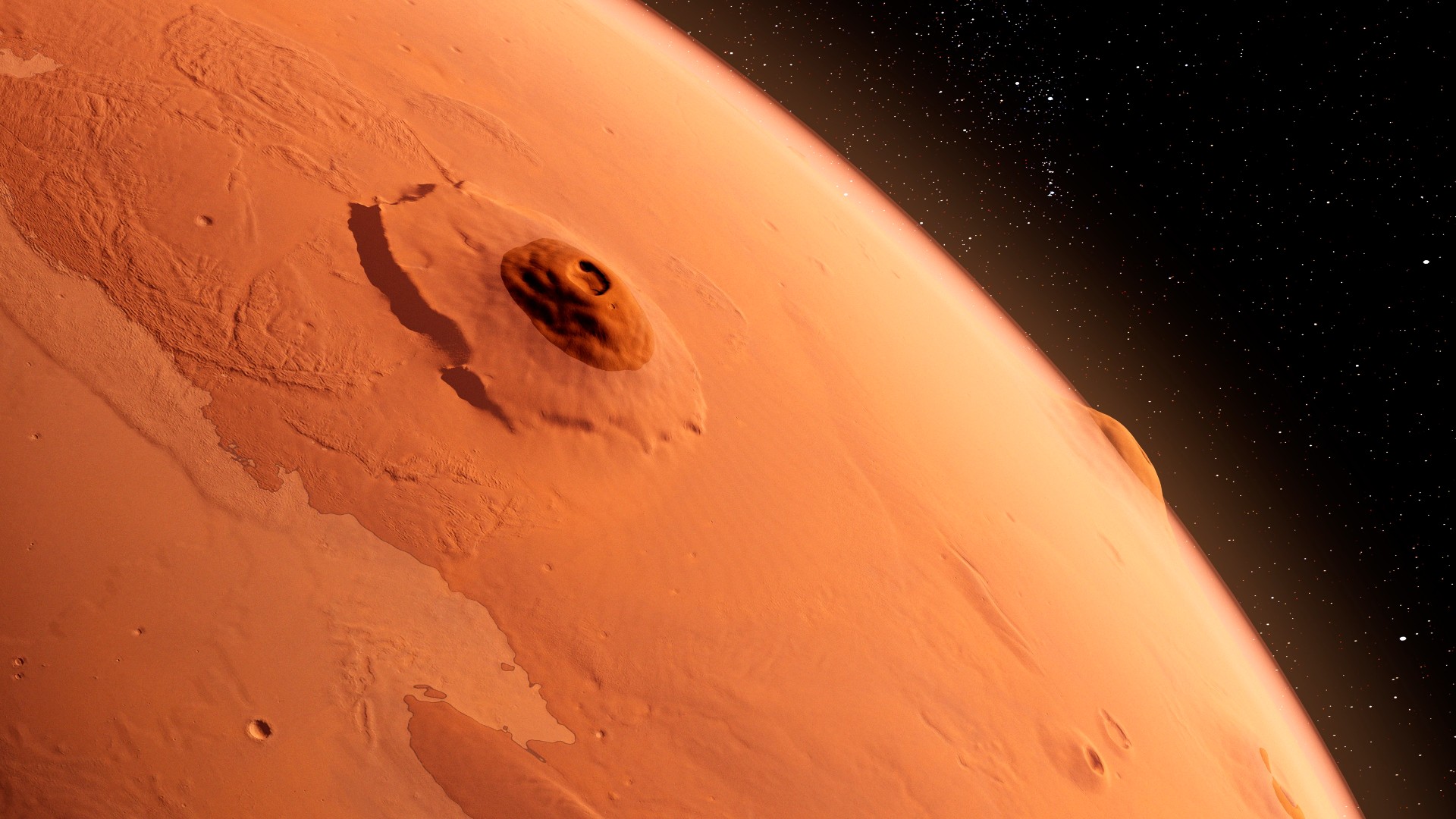Mars? Again?
A 280-mile-long volcano may have been discovered on Mars—hiding in plain sight
The colossal volcano is taller than Mount Everest, would reach from New York City to Washington, D.C., and may be a promising site to look for ancient remnants of microbial life.

It’s not every day you discover a brand-new gigantic volcano on another planet—but that’s exactly what a pair of researchers claim to have done. At almost 30,000 feet tall (a little higher that Everest), and perhaps 280 miles long at its base (lengthier than the distance between Washington D.C. and New York City), it is an utter behemoth. Like all volcanoes on Mars, there are no signs that’s it’s currently active. And it could be remarkably ancient—a volcanic witness to most of the Red Planet’s multi-billion-year history.
“We were both in disbelief that this was indeed a giant volcano and that no one seemed to have reported it before,” says Pascal Lee, a planetary scientist at the SETI Institute, one of the two co-discoverers. “I think it's fair to say that we were excited.”
Lee and his colleague presented their findings at the Lunar and Planetary Science Conference in The Woodlands, Texas, last week. Found overlaying an expansive maze of water-eroded caverns and tunnels named Noctis Labyrinthus—meaning “Maze of the Night”—the team have given their putative volcano the provisional name of Noctis, pending further analyses by the scientific community. The volcanic architecture has been heavily eroded by eons of water and glacial movement, which they claim is why Noctis has been overlooked until now.
Mars’s magmatic past
Not everyone agrees that a colossal volcano has truly been discovered. The work has yet to be peer-reviewed, but those who saw the presentation at the conference are intrigued, but skeptical.
“The researchers made an interesting case, but it is not entirely convincing,” says Rosaly Lopes, a planetary scientist at NASA's Jet Propulsion Laboratory who wasn’t involved with the new work. “The area is highly eroded. It is difficult to tell for sure.” But, she adds, “I think most of us still think it is an interesting idea and worthy of more study.”
Mars was once a volcanically active world, featuring myriad explosive and effusive eruptions—and the construction of some truly elephantine volcanoes, including the famous Olympus Mons, which is three times taller than Everest. It’s so weighty, it even sank back into the planet a little.

NASA Confirms Thousands of Massive, Ancient Volcanic Eruptions on Mars
Even though there are some tantalizing signs that future eruptions on the planet may occur, most scientists suspect Earth’s neighbor is past its eruptive heyday. And although small clusters of volcanic features are occasionally found by eagle-eye researchers, it’s presumed that the larger edifices have all be identified. Mars has an essentially transparent atmosphere, and aside from the odd global dust storm, its surface has been near-continuously perused by orbiting spacecraft, going back to NASA’s Mariner 9 satellite that arrived above the ochre world in 1971.
So when Lee, and fellow team member Sourabh Shubham, a Ph.D. student at the University of Maryland, claimed to have discovered a giant volcano, it came as a surprise.
Searching for an ancient volcano
Using a suite of orbital mission maps created over the past half-century, they focused on a field of deposits created by explosive volcanic activity, one that had been incised by the remains of a glacier. Wondering where this volcanic material may have erupted from, they looked nearby, to the eastern extent of Noctis Labyrinthus, and “we saw something remarkable,” says Lee: the shape of what they think is an eroded volcano, topped with a cauldron-like pit at its partly collapsed peak, and adorned with old lava flows, blankets of volcanic ash, and mineral patches cooked up by magmatically heated flowing water.
Giant Volcano Discovered on Mars
Based on the advanced extent of its erosion, the layering of its erupted matter, and comparing its fractures with those of Noctis Labyrinthus (whose formation time is broadly known), they suspect the volcano first took shape more than 3.7 billion years ago, then effervesced and erupted perhaps as recently as 10 million years ago.
“We are looking at a volcano whose activity spans the bulk of Mars' geologic history,” says Lee. And the presence of a prolonged heat source in an area known to have been adorned with glaciers also implies that this may be an exciting area for a future rover to explore—a former site of warm pools within which a robotic sleuth may find signs of past microbial life.
Despite Lee’s confidence, though, others aren’t convinced. The features identified as eruption deposits or volcanic landforms aren’t unequivocally volcanic, and it isn’t yet clear how continuous or not they are.
“This is not enough to convince me this is a volcano,” says Tracy Gregg, a planetary volcanologist at the University at Buffalo. “An impact crater that was filled and eroded could show similarities.”
While the possibility of a titanic overlooked volcano on Mars is tantalizing, more evidence is needed to confirm if this is truly an explosive new discovery.
Source
https://www.seti.org/press-release/giant-volcano-discovered-mars
https://www.jpl.nasa.gov/news/nasa-confirms-thousands-of-massive-ancient-volcanic-eruptions-on-mars
https://www.nationalgeographic.com/science/article/giant-mars-volcano-noctis
https://mars.nasa.gov/gallery/atlas/olympus-mons.html#:~:text=Olympus%20Mons%20is%20a%20shield,on%20Earth%20is%20Mauna%20Loa.
https://www.cnn.com/2024/03/29/world/mars-volcano-glacier-noctis-labyrinthus-scn/index.html



























































